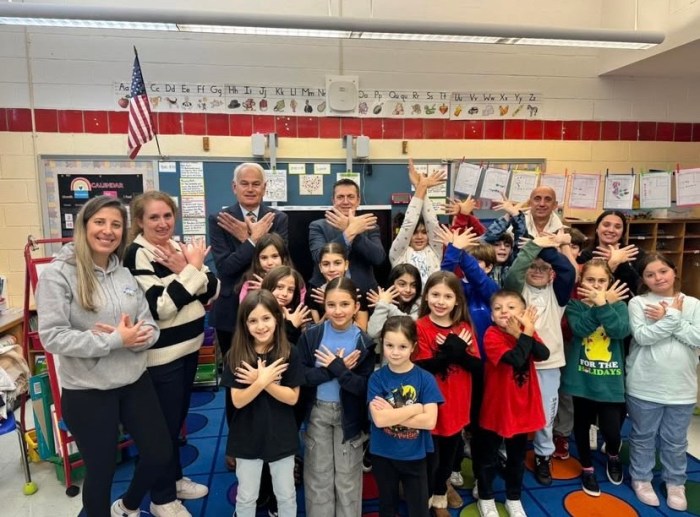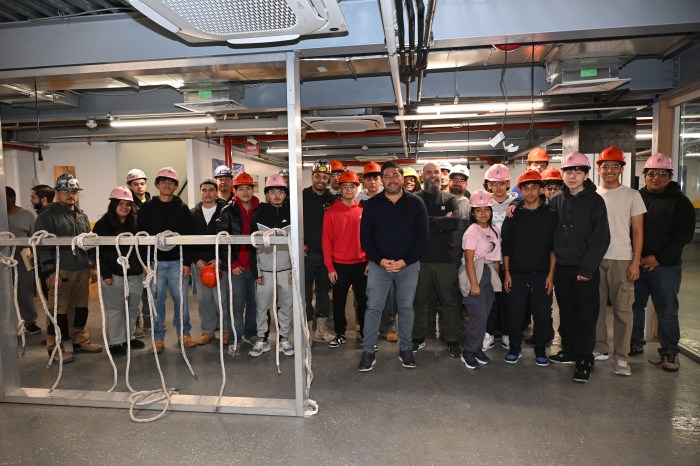Low Performance Rates Doom R’Wood H.S.
Low graduation and attendance rates and a reported lack of readiness for college among graduates at Grover Cleveland High School during the last school year played a role in the Department of Education’s (DOE) decision to close the Ridgewood institution this June, according to agency documents.
As reported in last week’s issue of the Times Newsweekly, the DOE announced last Tuesday, Feb. 28, its intention to close the high school located at 2127 Himrod St. once the current school year ends and open a new high school in its place in September.
Under the plan, all staff members at Grover Cleveland would need to reapply for their jobs at the new school, with the caveat that at least 50 percent of the current faculty will not return.
Parents and students at Grover Cleveland remain vehemently opposed to the closure plan. In previous weeks, they spoke at public meetings and held a rally around the Ridgewood campus calling on the DOE to allow the institution to remain as it is for the benefit of its students.
Following last Tuesday’s announcement, members of the school community launched an online petition campaign calling on Schools Chancellor Dennis Walcott to stop the turnaround plan.
“Due to the several components of that plan, we believe that Grover Cleveland High School will not and cannot benefit from it,” the petition read. “This is especially true in regard to the proposed termination of half of the high school’s staff. We, as a community, also ask the Department of Education to reconsider all options and to arrive at a viable solution to ensure the preservation and success of our educational institution.”
The DOE explained its proposal to eliminate Grover Cleveland in an environmental impact statement (EIS) provided to this paper last week.
According to the EIS, the DOE conducted a review of the Ridgewood high school after the state Education Department designated it as being “persistently lowest achieving” during the 2009-10 school year. The declaration allowed the city DOE to consider instituting a “closure intervention model” for the school as designated under the federal Elementary and Secondary Education Act.
Implementing one of the four improvement models outlined by the federal government also enabled the DOE to apply for a School Improvement Fund grant for various support services designed to enhance the quality of education received by all Grover Cleveland students.
During the spring of 2011, the DOE announced its intention to “phase-out” Grover Cleveland and replace it with several smaller high schools housed within the campus. Students and parents vigorously opposed the plan, arguing that the school had been making progress in recent years in improving graduation and attendance rates as well as educational programs.
False start for school’s restart
Eventually, the DOE reversed course and allowed Grover Cleveland to remain open under a “restart” model, in which high school administrators would team with a non-profit educational partnership organization (EPO) to make recommendations on how to boost achievement. In doing so, the school remained eligible to receive $1.7 million in federal funding, provided that the city and the United Federation of Teachers (UFT) could agree on the implementation of a teacher evaluation program by New Year’s Day 2012.
However, both parties were at an impasse on the evaluation plan when the Jan. 1, 2012 deadline arrived. With that, Grover Cleveland and several other city high schools under the “restart” or “transformation” models- including Long Island City and Bryant high schools in Long Island City-became ineligible for the supplemental federal grant.
As a result, the DOE announced that it would abandon the “restart” model at Grover Cleveland and institute a “turnaround” which called for dismissal of the high school’s principal and at least half of the current staff. The program also results in the development of new instructional and support programs.
Closing Grover Cleveland and replacing it with a brand new school will achieve two objectives for the DOE, according to the EIS. First, the agency will be able to “align the intervention strategy with the school’s most recent performance data and most recent assessment of steps needed” to improve performance. Secondly, the DOE will also “be able to immediately increase the quality of teachers” serving the students.
DOE: The numbers don’t add up
Though the DOE acknowledged that there were “some positive trends in student progress” at Grover Cleveland during the 2008-09 and 2009-10 school years, the EIS noted that the institution’s “metrics declined during the 2010-2011 school year across most progress and performance measures.”
Grover Cleveland’s four-year graduation rate was 58 percent in 2010-11, down from the 62 percent rate in the previous school year; the citywide average was 65.1 percent in 2010-11. Moreover, the DOE noted that the school’s graduation rate has “been consistently low for years.” The six-year graduation rate was 65 percent, the report added, up from 59 percent recorded in 2008.
The EIS also determined that just 13 percent of the graduating Class of 2011 were deemed “prepared for college after four years in high school,” 12 percentage points lower than the citywide average.
The report also found that Grover Cleveland’s 81 percent attendance rate during the last school year placed it in the bottom 17 percent of city public high schools. While there was a strong performance by students who took the English and Global Studies Regents, it was noted that many graduates at Grover Cleveland had not achieved a Regents diploma.
The agency declared that Grover Cleveland “was struggling even more than the DOE had thought” at the time it chose to implement the restart model. The Board of Regents had also told the DOE “that the pace of change in some” of the transformation and restart schools “was not quick enough to meet the challenges faced.”
Based on those statistics and other criteria, the DOE indicated in the EIS that Grover Cleveland students “would be better served by implementation of a more intensive intervention.”
New school plans
If Grover Cleveland is closed, the principal of the new school will be tasked with developing and implementing “school-based competencies” for hiring new teachers. A personnel committee consisting of the principal, two UFT appointees and two appointees of the chancellor or superintendent will be assigned to review and screen all applicants based on the set criteria.
Incoming freshmen will be accepted to the new school through the standard admission process, while all incoming sophomores, juniors and seniors at Grover Cleveland will be guaranteed seats at the new school.
The DOE indicated that it intends to expand on the existing educational programs at Grover Cleveland, including its five career-based academies that focus on industries such as business management and information technology. The new school’s curriculum will also include arts programming and “common core learning standards and rigorous academic courses in science and foreign language.”
As announced, a public hearing regarding the proposal will be held on Monday night, Apr. 2, at 6 p.m. at Grover Cleveland’s auditorium.



































